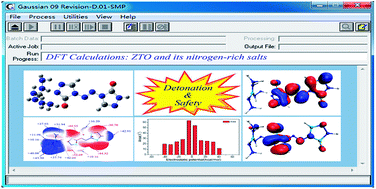Theoretical study of a series of 4,4′-azo-1H-1,2,4-triazol-5-one based nitrogen-rich salts as potential energetic compounds†
Abstract
Density function theory has been employed to systemically study 4,4′-azo-1H-1,2,4-triazol-5-one (ZTO) and its six nitrogen-rich salts at two different calculated levels (B3LYP/6-31G(d,p) and B3PW91/6-31G(d,p)). Their optimized geometries, electronic structures and molecular electrostatic potentials were further studied. Based on the two computed methods, the results of the optimized geometries show that the calculated structure of each compound adopted at the two different levels are rather similar except salt 7 with some differences. The values of the energy gaps indicate that compound 3 has the highest reactivity among salts 2–7. The crystal densities were corrected using the Politzer approach based on these two optimized levels. The density values with slight deviation indicate that the two calculated levels are applicable and the results are convincible. Based on the isodesmic reactions and Born–Haber energy cycle, the solid-phase heats of formation (HOFs) were predicted. Detonation parameters were evaluated using the Kamlet–Jacobs equations on the foundations of the calculated densities and HOFs. The results manifest that salt 2 exhibits the best detonation performance due to its highest density (1.819 g cm−3), followed by salt 6. Moreover, impact sensitivities of compounds 1–7 were assessed using the calculated Q values to correlate with h50. Combining the detonation performance with safety, 1–7 exhibit good comprehensive properties and might be screened as a composition of modern nitrogen-rich energetic compounds.



 Please wait while we load your content...
Please wait while we load your content...